A what to do in Gyumri guide with a map of locations
Introducing Gyumri, Armenia
Gyumri is Armenia’s second-largest city. It is located 120kms northwest of Yerevan, 50kms from the Armenian/Georgian border and a mere 10kms, as the crow flies, from the frontier with Turkey. Public transport connections from elsewhere in Armenia, as well as neighbouring Georgia, are good and there are enough things to see in Gyumri to keep you busy for at least a day, as well as a couple of interesting side trips into the surrounding countryside if you decide to stay longer. We’ve visited Gyumri twice and, all-in-all, really like the city and would recommend it to others.
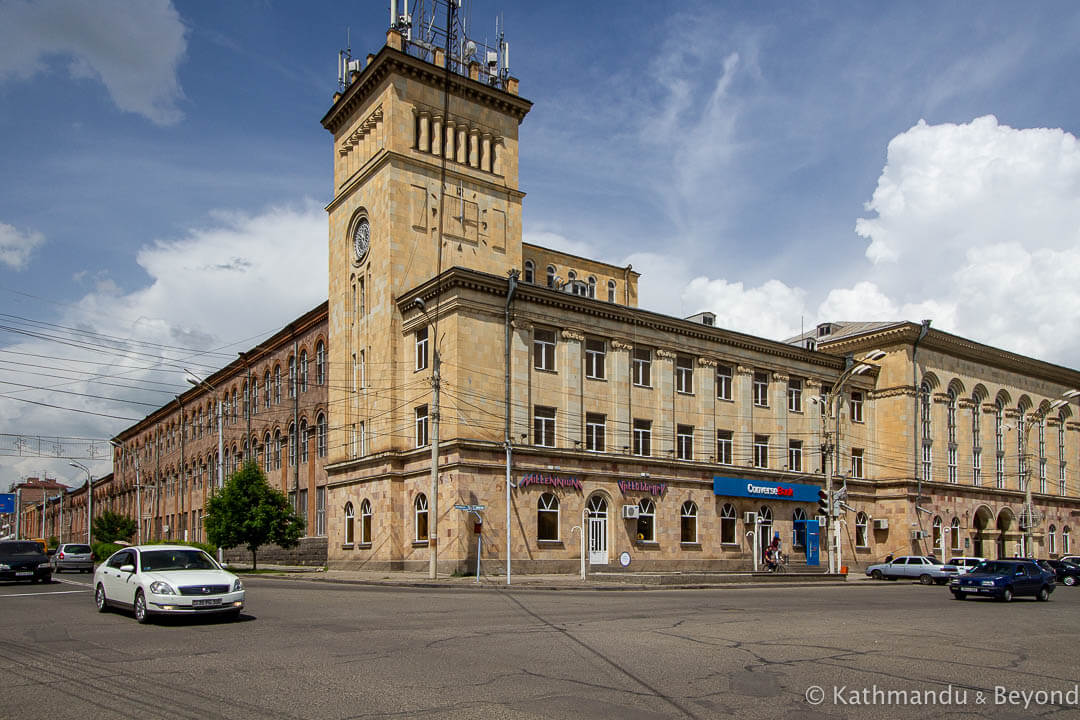
I wasn’t intending to go into too much detail about the history of Gyumri. Needless to say, like most cities in Armenia, it has a long and varied past but there are a couple of periods that lead into one another, as well as one specific event in Gyumri’s more recent history that are worth expanding upon as they will help appreciate the city’s present-day appearance.
The first of these was the city’s strategic importance (10kms from the Turkish border) within the Russian Empire and the role it played in the Russo-Turkish Wars, a series of twelve military conflicts that took place between the Russian and Ottoman empires between the 17th and 20th centuries. I won’t get into the nitty-gritty of the specifics but because the city, which was renamed Alexandropol from its original ancient name of Kumayri in 1837 by Tsar Nicholas I, was part of the Russian Empire, many of the buildings that you will see while wandering around were constructed during this time. This is especially the case in the historic neighbourhood, which is still called Kumayri. Here, you will find Tsarist Russian architecture in various structural conditions, ranging from painstakingly restored to dilapidated and seemingly on the verge of tumbling down. Kumayri spreads out from Vartanants Square towards Gorky Park in the west and the railway station in the east. Additionally, we found lots of residential Russian-era architecture on the side streets immediately to the east of Vartanants Square.
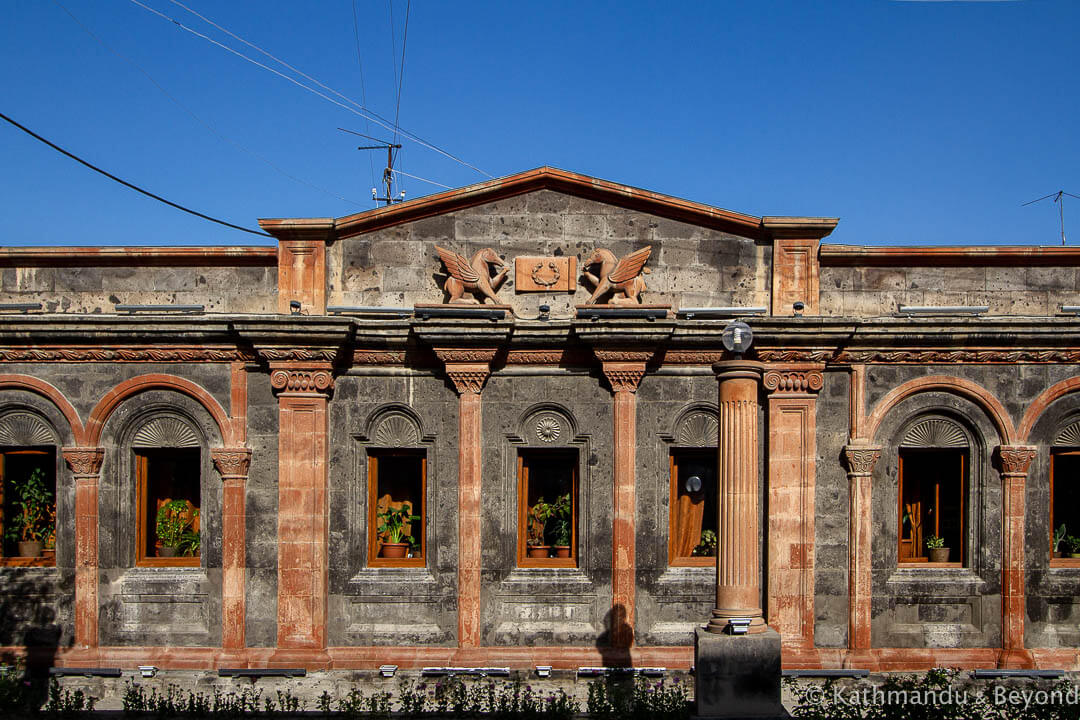
As I’m sure everyone knows, the Russian Empire was followed by the Soviet Union and this is another noticeable characteristic of Gyumri’s architectural impression. Known as Leninakan (after the deceased Soviet leader) during Soviet rule, there are still structures as well as monuments and memorials from the Soviet period that can be seen in Gyumri. For example, the second-largest Mother Armenia in the country (after the one in Yerevan) is only a short distance from the centre of the city and, in addition, there are some good examples of Soviet Modernist architecture scattered here and there. Our suggestions on what to see in Gyumri include stuff from the Soviet period along with the more conventional sights.
Finally, the most recent event to shape Gyumri’s urban skyline was the disastrous 1988 Armenian Earthquake that hit this region of Armenia on 7th December 1988. Measuring a magnitude of 6.8 on the Richter scale, the devastation was widespread in the north of the country, killing in the region of 25,000 people and injuring and/or leaving homeless hundreds of thousands more.
Gyumri and its inhabitants suffered greatly and the city is still on the road to recovery. Throughout the city, visual reminders of the earthquake can be found, either in the form of recently erected memorials, or restoration work that is still ongoing, or damaged structures that haven’t been touched since that fateful day.
Keeping the above in mind, Gyumri is unlike any other place we have visited in Armenia. Is it a depressing city? … not in the slightest, we’ve enjoyed both our visits. It sounds corny to say it, but the people of Gyumri have spirit and are among the friendliest Armenians we have met. Making room for us in a packed restaurant, helping us locate out-of-the-way Soviet-era monuments and offering us shelter from the mother of all storms – I really don’t want to favour Armenians from one part of the country over another because, to our minds, they are generally one of the nicest people on the planet but there is something about the inhabitants of Armenia’s second city that gives it a slight edge and therefore makes it a great place to get to know.
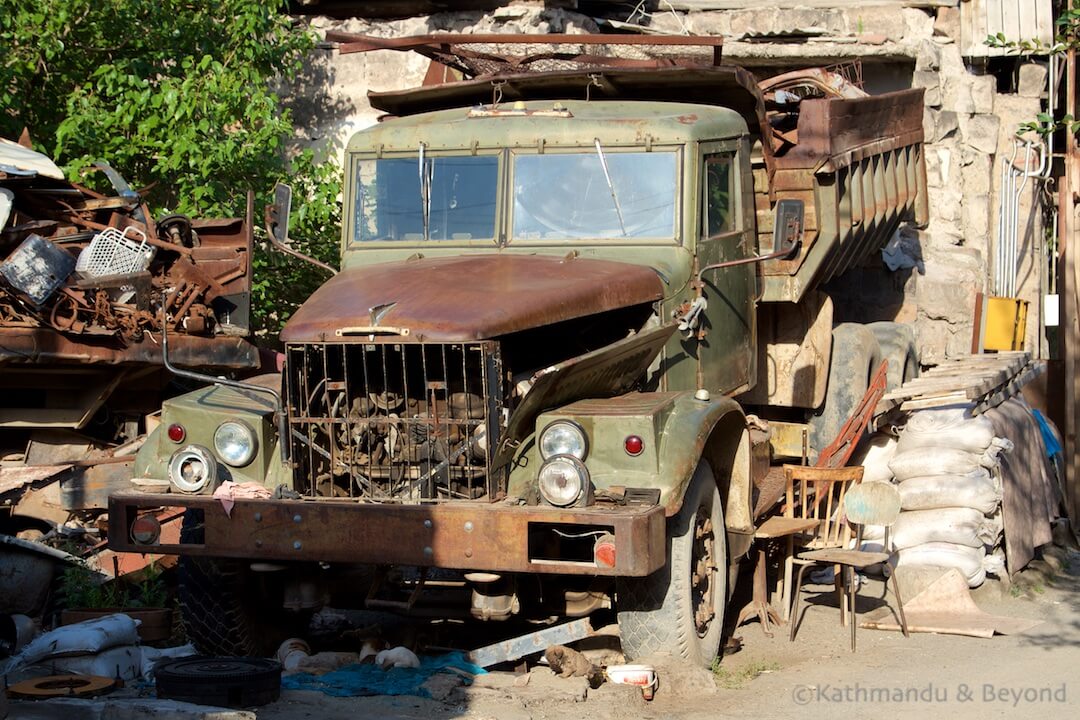
Places to visit in Gyumri
In order to complete our list of places to visit in Gyumri, you will have to put in quite a bit of legwork, but everything detailed below can be seen on foot. Hence, what I’ve done is begin by listing the places of interest in the centre of the city before moving south then west, followed by north and finally east.
Vartanants Square
The largest square in the city, this is the logical place to begin any visit to Gyumri. Dating back to the 1930s and Soviet rule, the original blueprint for Vartanants Square was based on a layout by Alexander Tamanian, the well-known Armenian architect responsible for designing much of modern Yerevan in the mid-1920s. The most notable building on the square is City Hall, which was heavily damaged during the 1988 earthquake but later rebuilt based on its original design.
Holy Saviour’s Church and 1988 Earthquake Memorial
Just south of Vartanants Square is Holy Saviour’s Church, the city’s most impressive house of worship and one of the top places to visit in Gyumri. Dating back to 1873, the design of the church is based on the Cathedral of Ani, now in Eastern Turkey. Holy Saviour’s Church survived the region’s other major earthquake, which took place in 1926, but took a severe battering during the one in 1988. Renovation work on the church has been taking place since 2002 but progress has been slow and the proposed 2015 reopening deadline came and went. From what I understand, it has yet to be opened as a functioning church (*).
(*) When we first visited Gyumri in the summer of 2015, a large crane was attached to the side of the structure. When we returned to the city three years later, the crane had gone and there was little evidence of renovation work taking place but the church was still closed.
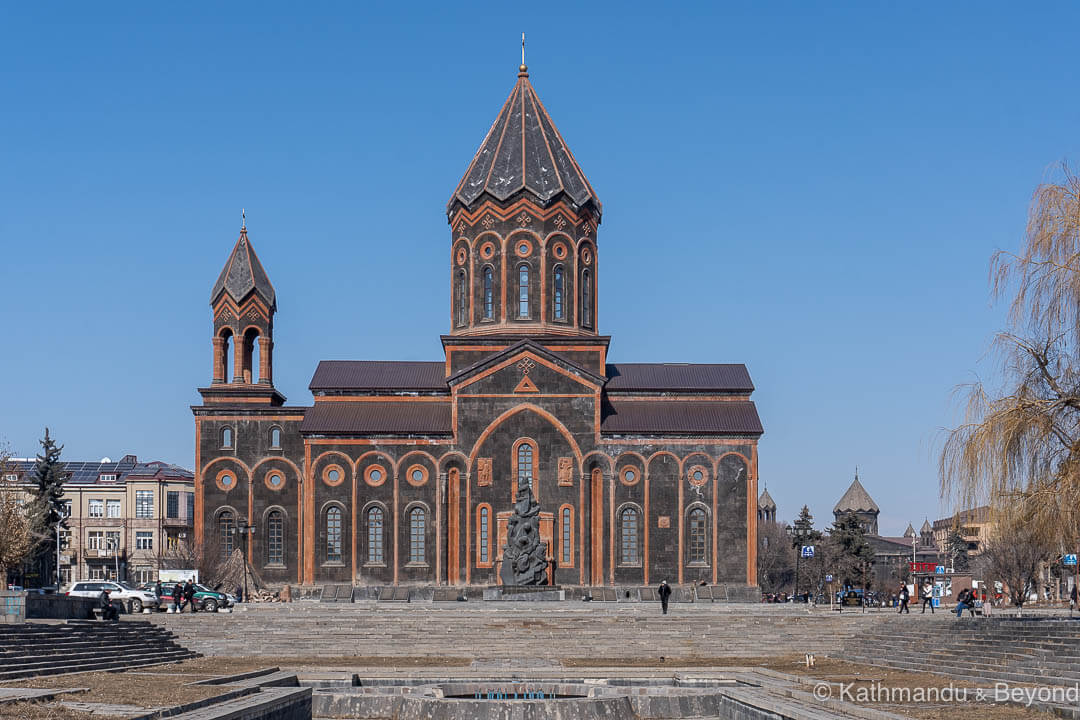
Outside Holy Saviour’s Church is a thoughtful monument to the victims of the 1988 earthquake. Completed in 2007, the sculpture is also an acknowledgement to those outside Armenia who gave their assistance in the aftermath of the event (*).
(*) In a move unprecedented in the USSR, the then leader, Mikhail Gorbachev, appealed to the international community to help Armenia. The response was positive and resulted in the largest foreign cooperation since the Second World War.
Cathedral of the Holy Mother of God
The other church in the vicinity of Vartanants Square is the Cathedral of the Holy Mother of God. Also called Astvatsatsin Church or, more locally, Yot Verk (Seven Wounds: an abbreviation of another of its names, Our Lady of Seven Wounds), this church has been fully restored. On the lawn outside you can see two pre-1988 domes from the church. According to the information on the plaque attached to the domes, when the tremor struck, they shot off the church, taking most of the earthquake’s shock waves with them and hence saving the bulk of the structure from being gravely damaged.
Unlike Holy Saviour’s Church, which was used as a museum and then a music hall during Soviet times, the Cathedral of the Holy Mother of God remained a place of worship throughout.
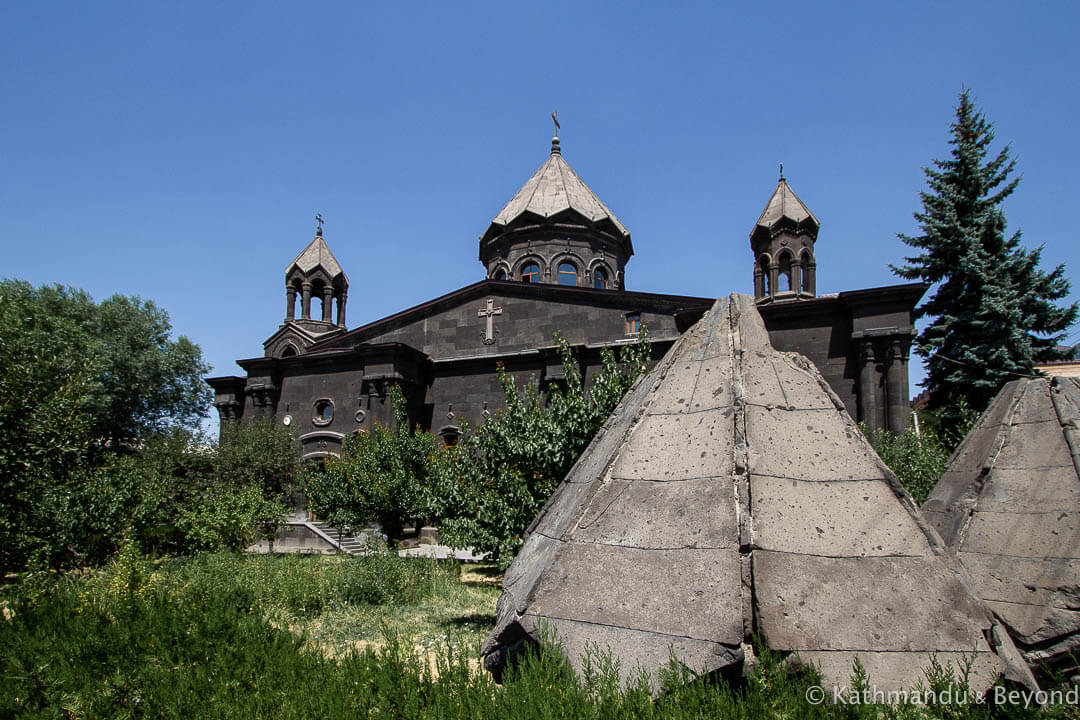
Soviet-era monuments in the small park to the east of Vartanants Square
If monuments from the Soviet times interest you then it is worth taking a stroll through the skinny park to the east of Vartanants Square. If you don’t want to miss any of the monuments on display then it’s best to enter the park via its northern entrance, which is opposite Peace Circle Park, and make your way south to the other end of it.
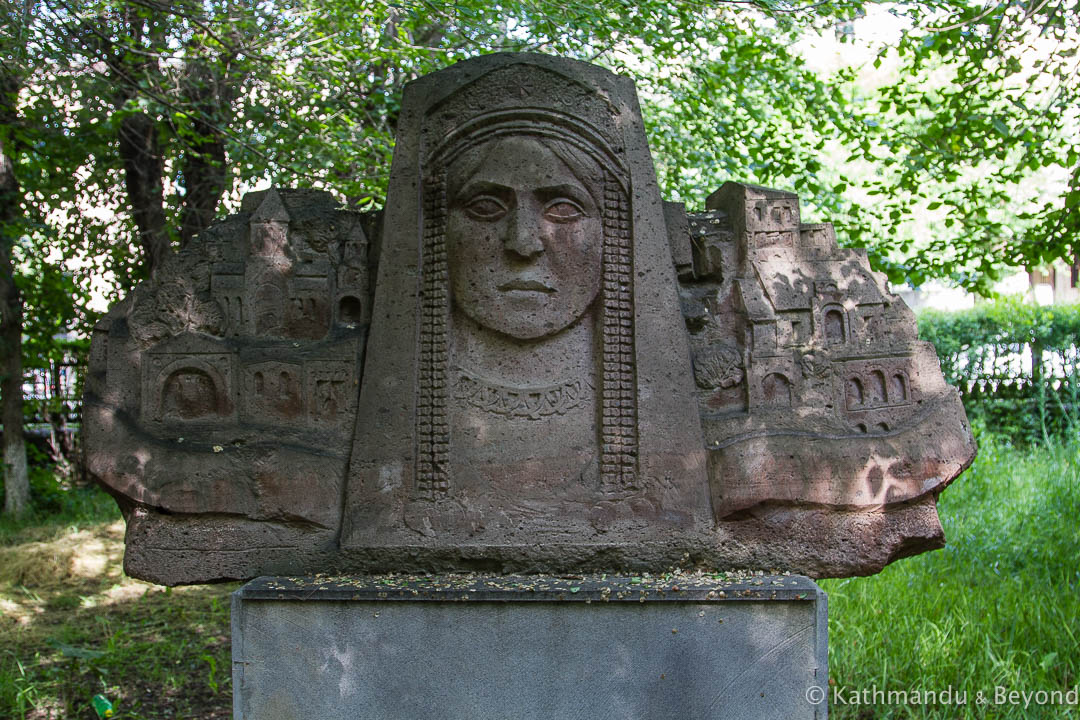
The (Blue) Iron Fountain
This is definitely one of the less-conventional places to visit in Gyumri, and I’ll get to Gyumri’s more well-known iron fountain later in this post, but beyond the southern end of the small park mentioned above, is another disused iron fountain that not many people know about but is worth a quick look. For ages, I could find nothing out about it but eventually, I discovered that it dates back to the 1970s and was the work of Artur Tarkhanyan, a Gyumri-born architect who was not only responsible for the city’s other iron fountain but also worked on many other architectural projects in Armenia during Soviet times. These include Cinema Rossiya, the Karen Demirchyan Sports and Concerts Complex and the Armenian Genocide Memorial, all of which are in Yerevan and are mentioned in more detail in our what to do in Yerevan guide.
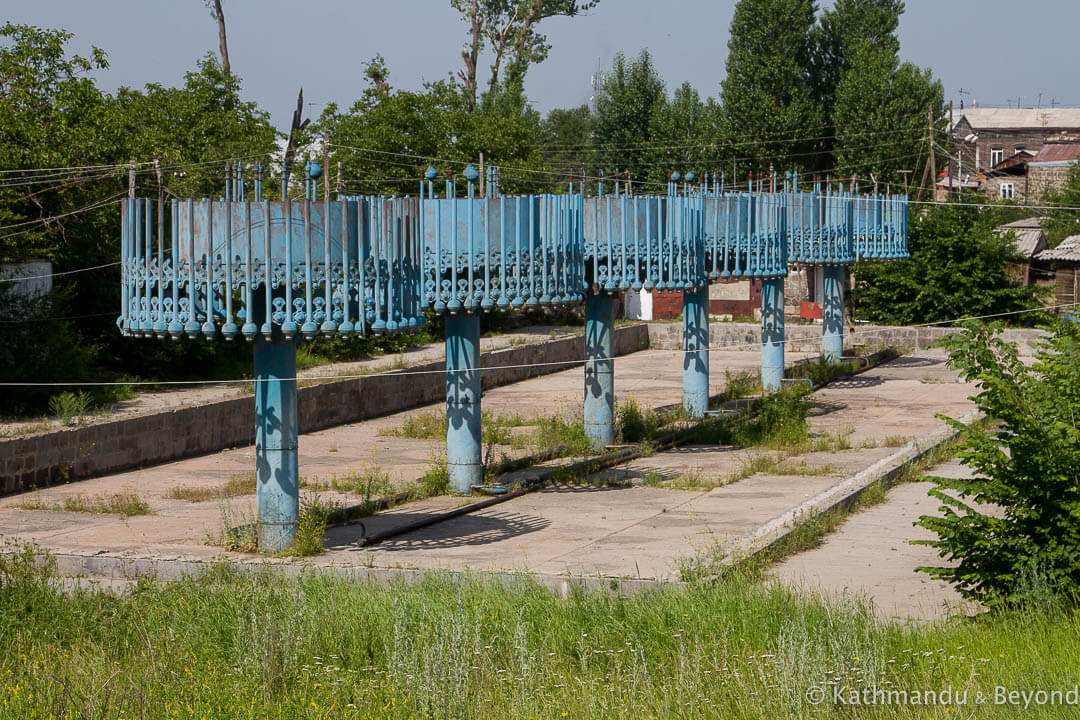
Gyumri’s bus and marshrutka (fixed route minivan) station, which you are going to need if you want to head to any of the places mentioned in the day trips from Gyumri section detailed below, is just a few hundred metres southwest of the fountain.
Gyumri Market (shuka)
I’m not normally a fan of markets but the one in Gyumri is pretty interesting and worth spending time in. It is also a friendly place – foreign tourists aren’t that common in Gyumri and Armenians are an affable bunch so expect a bit of interaction and jovial banter if you decide to pay the market a visit (*).
(*) Actually, the same goes for the bus station!
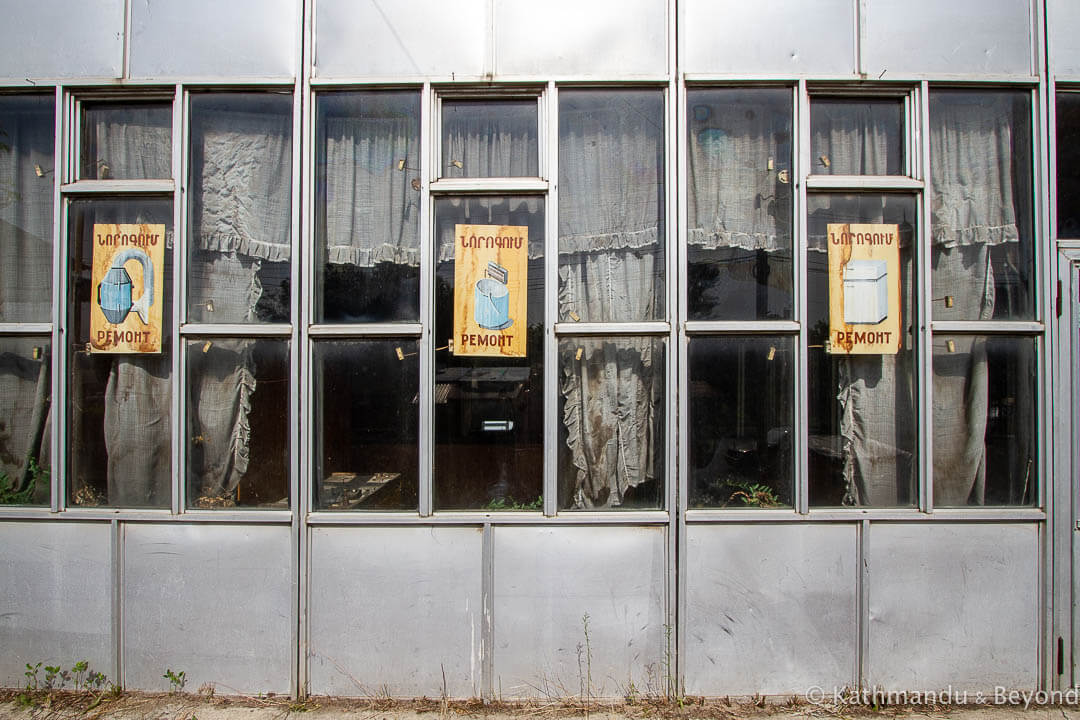
Saint Michael the Archangel Russian Orthodox Church
Saint Michael’s was consecrated in 1886 and, because of its silver roof, it was known as ‘Piplan Zham’ – the Shimmering Chapel. The church is located on the Hill of Honour, a Russian military cemetery for soldiers who lost their lives battling against the Ottoman Empire. The monument within the grounds of the church, of which the back side of it can be seen in the photo below, honours those who fell during the capture of the fortress in Kars (1877), a small city in northeastern Turkey which also has a historical connection to the Russian Empire. The monument is a replica of the original, which was erected in Kars in 1910. The church, which is also called St. Nikolai the Wonderworker Church, is located 750 metres west of the market.
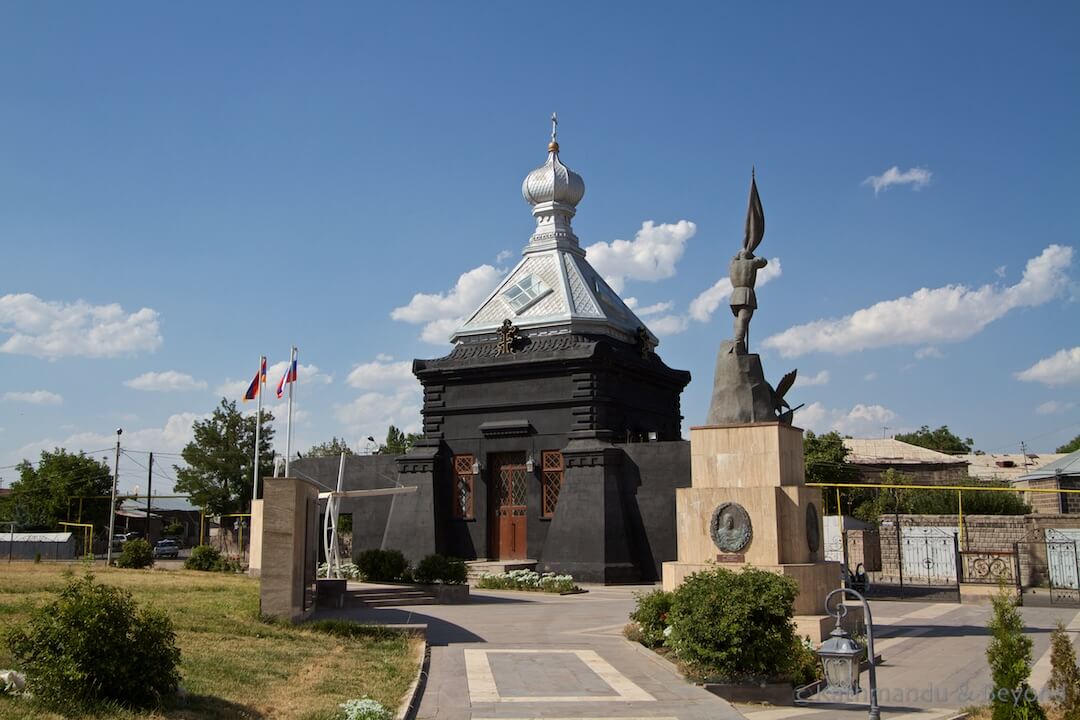
Gorky Park
Gyumri’s central park is a good place to come for a wander and a bit of people-watching. If you want a specific reason to visit then I would say that the view across to Mother Armenia from the park’s southern tip is one good one and another would be to check out the large Soviet-era sculpture that is located near the northern entrance. Called “Monument to Song and Writings”, it depicts a teacher and his pupils.
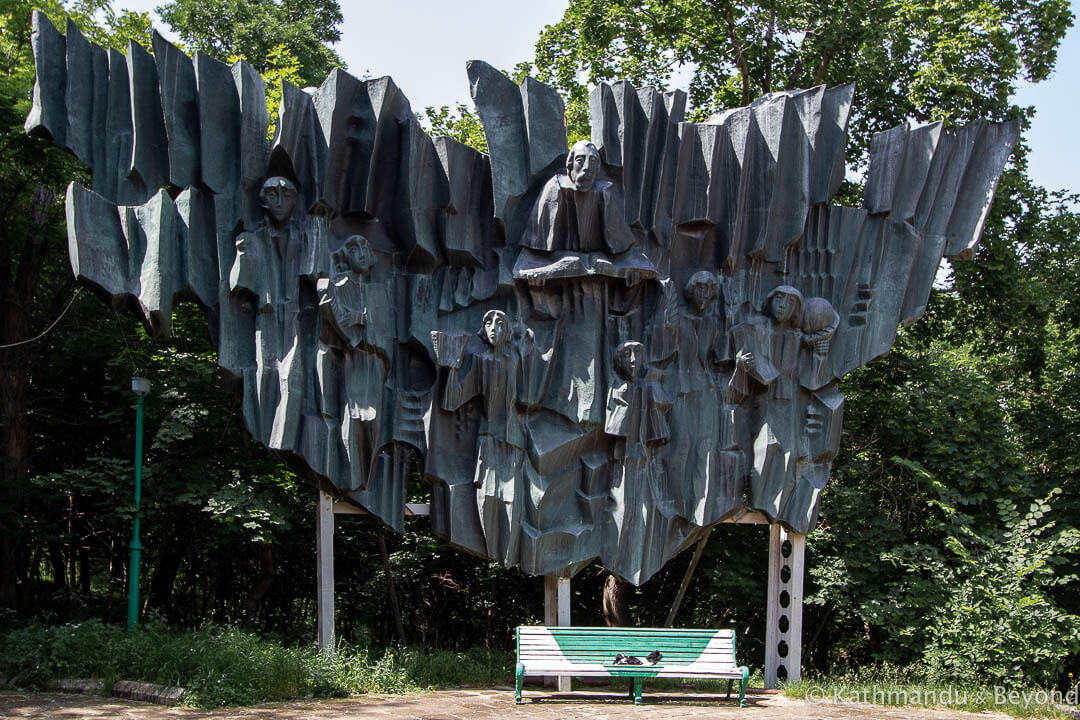
Monument to the Great Patriotic War en route to Mother Armenia
This eye-catching monument is located on a bend just before you reach the Mother Armenia complex proper. It was erected at some point in the 1980s and therefore not as old as the monuments associated with Mother Armenia.
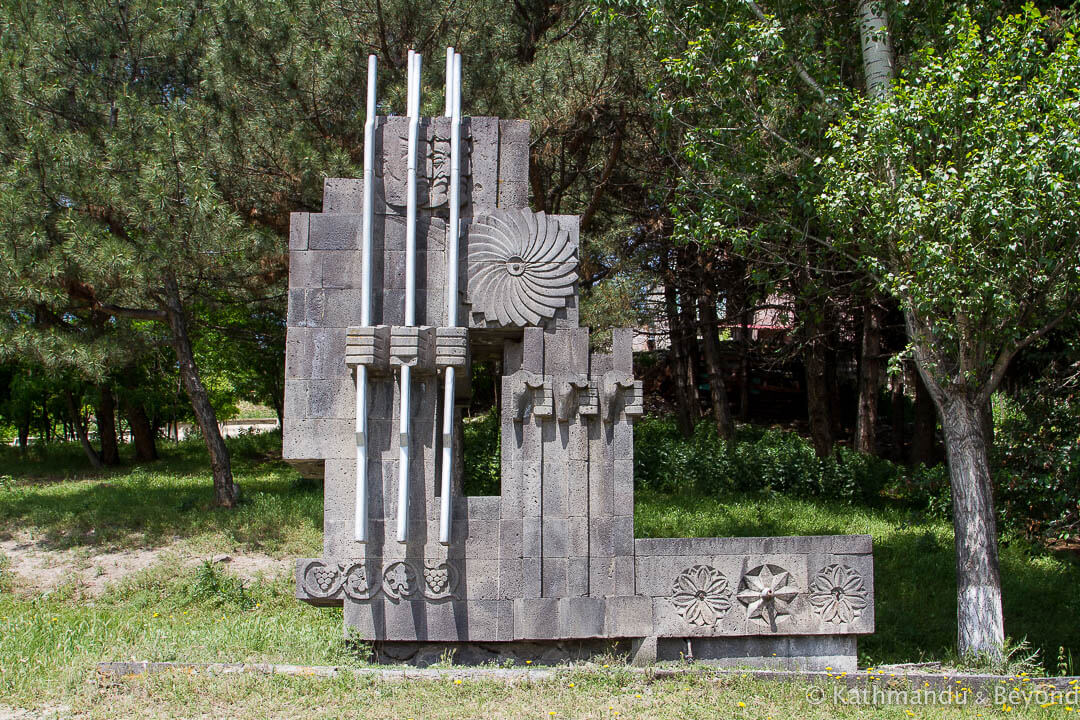
Monument to the Great Patriotic War at the foot of the Mother Armenia Complex
Depicting a Soviet solider, this solemn-looking monument was set back from the main path and partially camouflaged by foliage so keep an eye out if you want to see it.
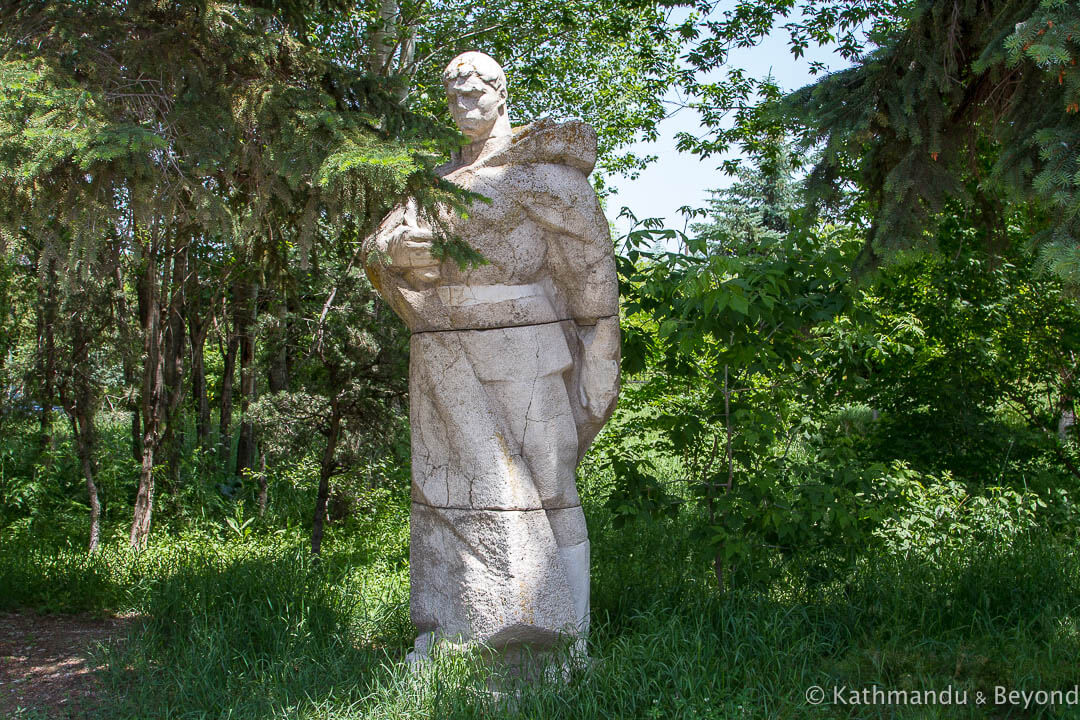
Mother Armenia
The Mother Armenia statue in Gyumri is a smaller version of the one in Yerevan’s Victory Park. It was erected in 1975 (the one in Yerevan dates back to 1967) and is the tallest sculpture in the city. The stone blocks en route to the dual staircase that leads up to the monument are each inscribed with the names of the Soviet Hero Cities of the Great Patriotic War (World War II). The title Hero City, which is equivalent to the Hero of the Soviet Union honour given to individuals, was awarded to twelve Soviet cities and one fortress for exceptional heroism during the war. The cities are Leningrad (Saint Petersburg), Stalingrad (Volgograd), Odessa, Sevastopol, Kiev (Kyiv), Moscow, Kerch, Novorossiysk, Minsk, Tula, Murmansk and Smolensk. The fortress is the remarkable Brest Hero Fortress in Belarus.
If it’s a sunny day, visit the Mother Armenia Complex in Gyumri in the morning if you want to get a decent photo because, by the afternoon, the sun will be directly in front of you.
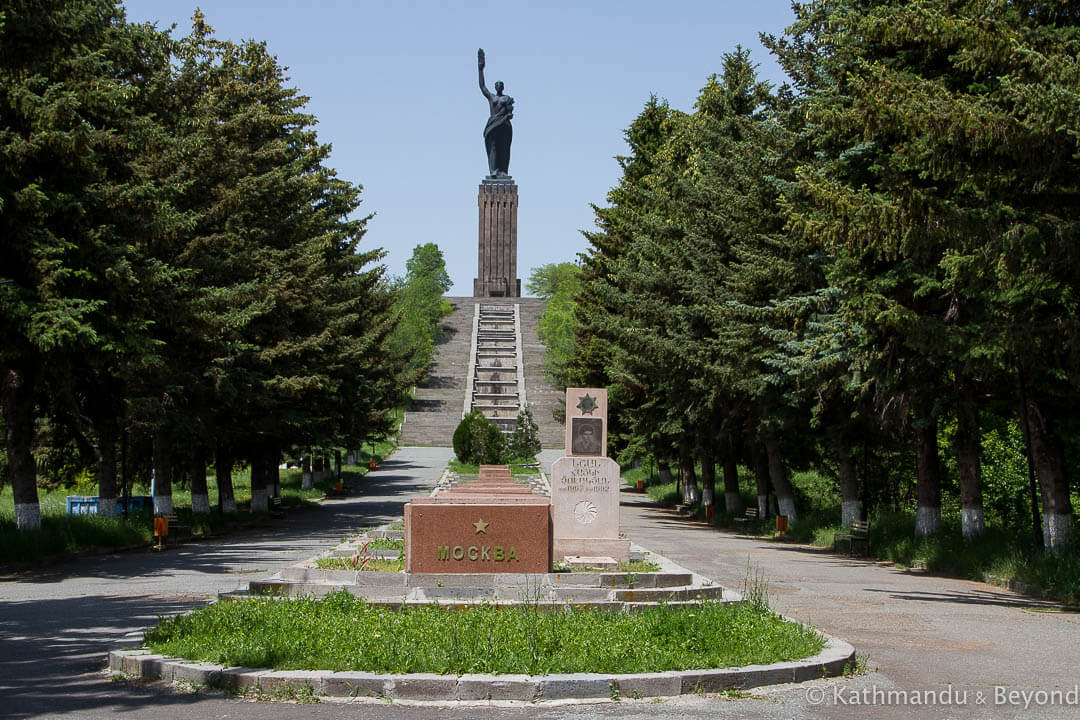
Black Fortress
Dating back to 1834, this oval-shaped fortress was originally built as a defensive structure to protect the Russian Empire from its enemies, namely the Persians and then the Turks, but has also been used as a military prison as well as an artillery repository throughout its history. The citadel now hosts concerts and cultural events. The plan is to turn it into a tourist attraction but to the best of my knowledge, this has not yet happened and, apart from special occasions, it remains closed to the public. You get the best panoramic view of the fort from the plateau on which Mother Armenia is located.
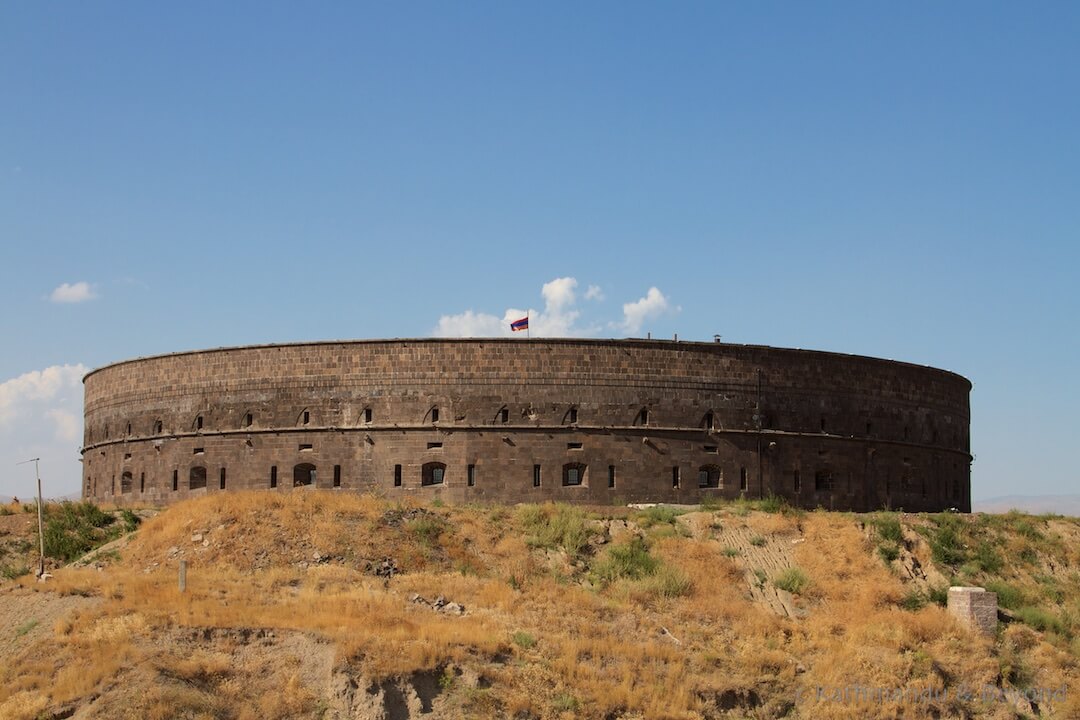
Old hospital ruins
A victim of the 1988 earthquake, this former neurological hospital is of limited interest purely because, certainly in summertime, the dense undergrowth that surrounds the ruins makes it almost impossible to infiltrate. Hence, you can walk around it and peer in here and there but that’s pretty much all you can do. Maybe it’s different at other times of the year when there’s less greenery around?
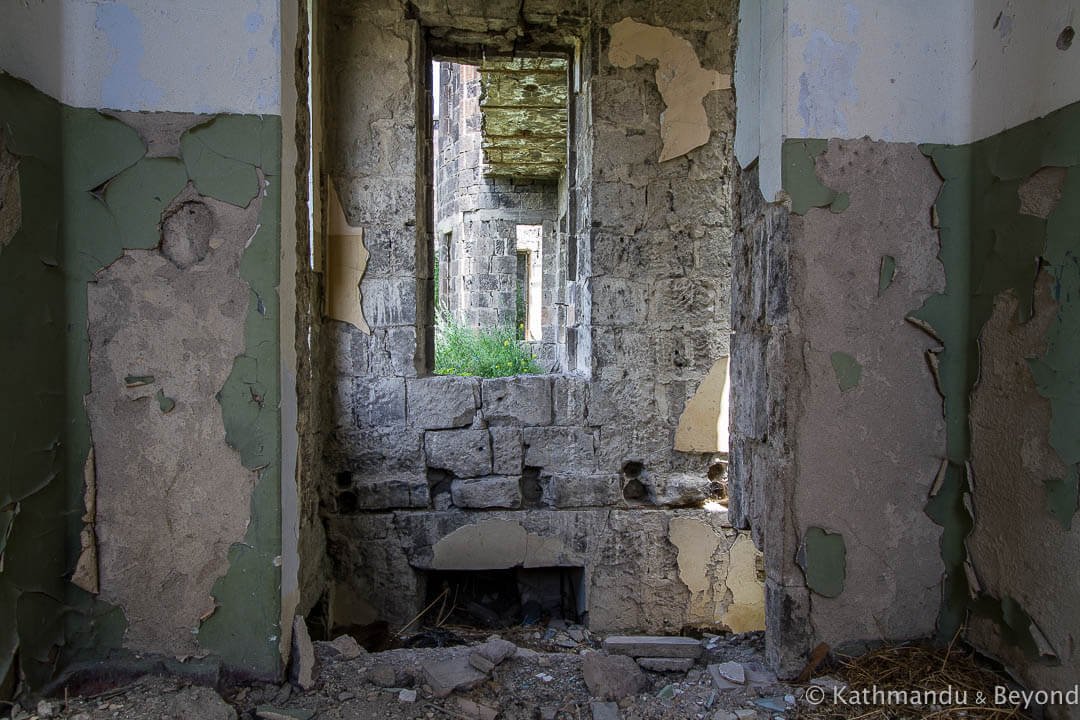
The Iron Fountain in the former university campus
This mesmerising iron fountain was once the main feature of the Polytechnic University of Gyumri campus. When the earthquake hit, it was the only structure in the vicinity that was not wholly destroyed. Our main purpose for visiting Gyumri for a second time was to see this fountain and the fact that we witnessed it to the backdrop of the most incredible brewing storm makes it one of the most memorable things we have seen in the Caucasus. You can see more photos from that stormy day, as well as additional facts about the fountain itself, by clicking on the link at the beginning of this paragraph.
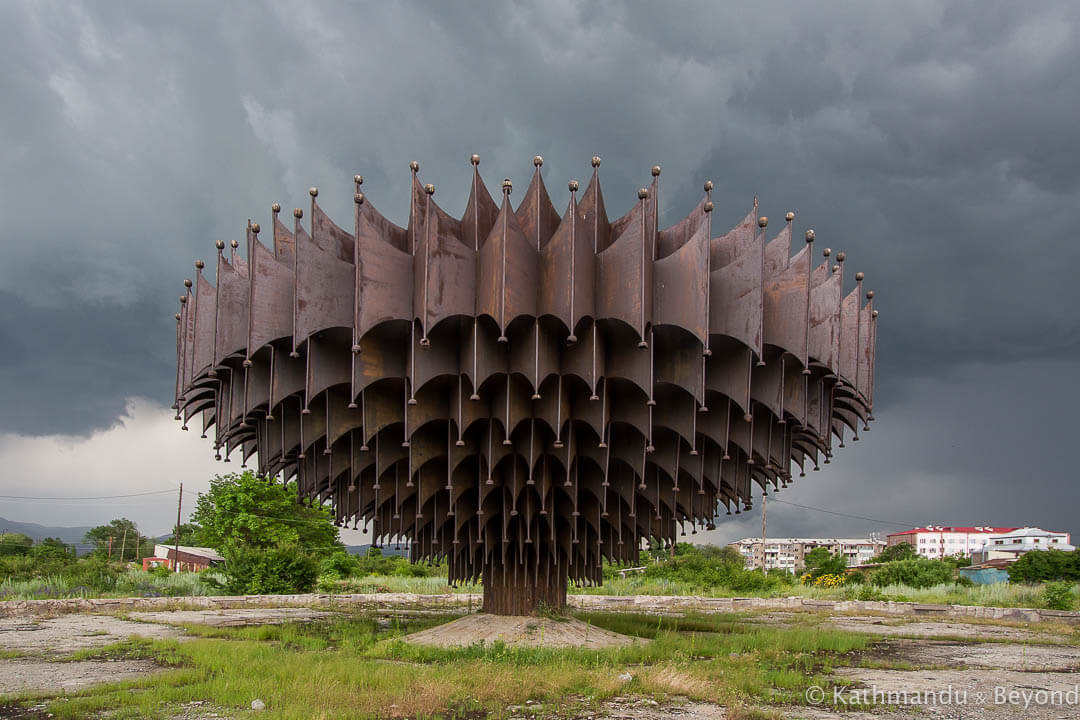
Earthquake-ruined building on Garegin Nzhdeh Avenue
As mentioned in my intro, structural reminders of the devastation caused by the 1988 earthquake can still be seen in many parts of the city but one of the most dramatic that we came across was on Garegin Nzhdeh Avenue, the main artery linking downtown Gyumri with the district encompassing the former university campus. If you were to walk past the building in a southerly direction you probably wouldn’t notice it, but coming the other way presents a completely different perspective that is quite an amazing sight.
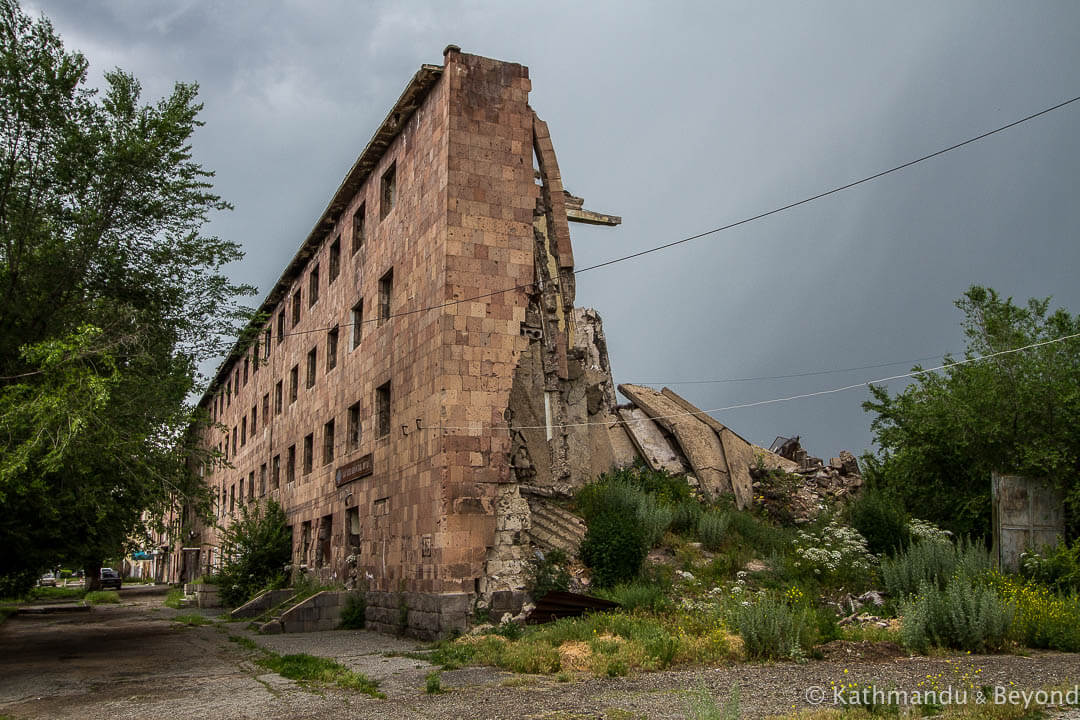
Monument to the 60th Anniversary of Leninakan
Slightly set back off the main road, this monument commemorates the 60th anniversary of the changing of the city’s name from its Imperialist Russian one of Alexandropol to its Soviet one of Leninakan in 1924 (*). As you can see from the map attached to this article, it is very close to the ruined building mentioned above, yet, incredibly, it survived the earthquake relatively intact.
(*) Thank you to Stefan Spassov for the information about this particular monument. Check out his Instagram account (@theforgottencivilization) for some fascinating photos from Bulgaria.
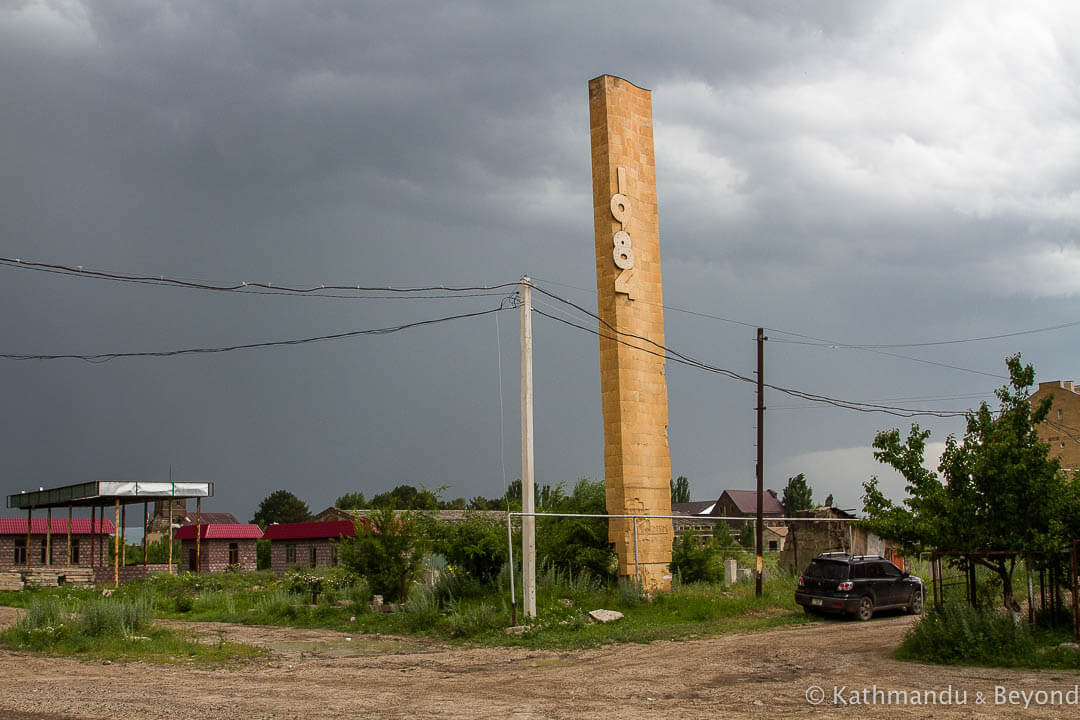
Monument to Textile Factory Workers
Gyumri was an important producer of textiles during the times of the Soviet Union and this sculpture, which is a good example of socialist realism, is an acknowledgement of this fact.
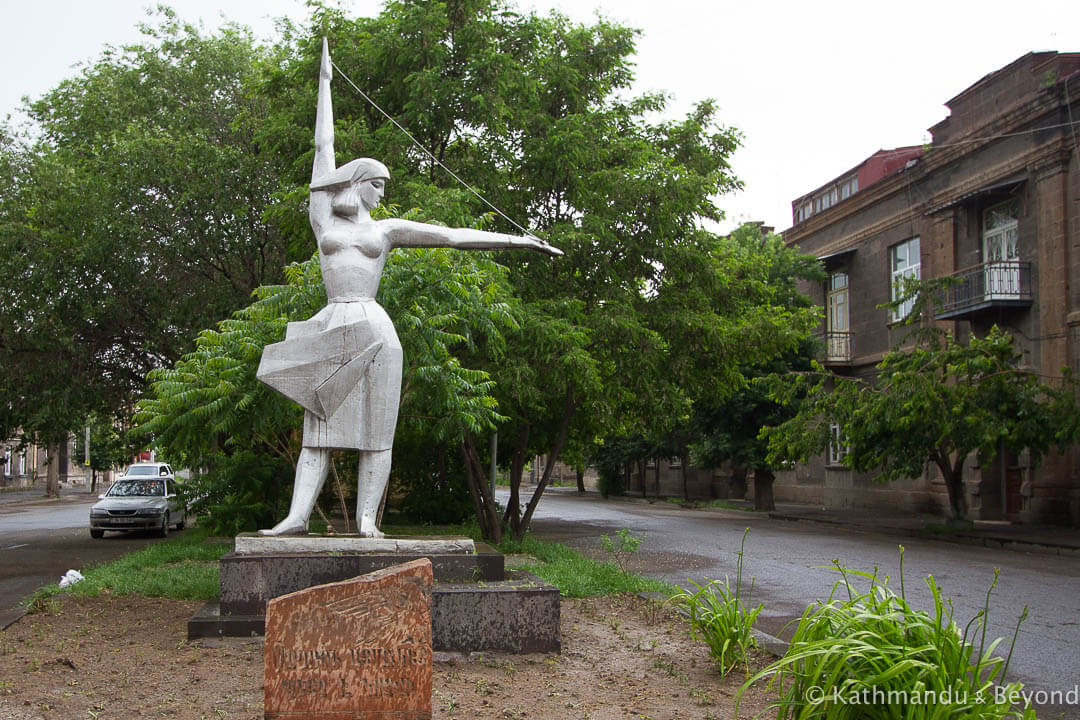
Vardan Ajemyan Drama Theatre
A template for Soviet modernist architecture, Gyumri’s main theatre still regularly puts on performances. If you decide to check this particular building be sure to also take a look at the ornate stone relief that flanks its main entrance.
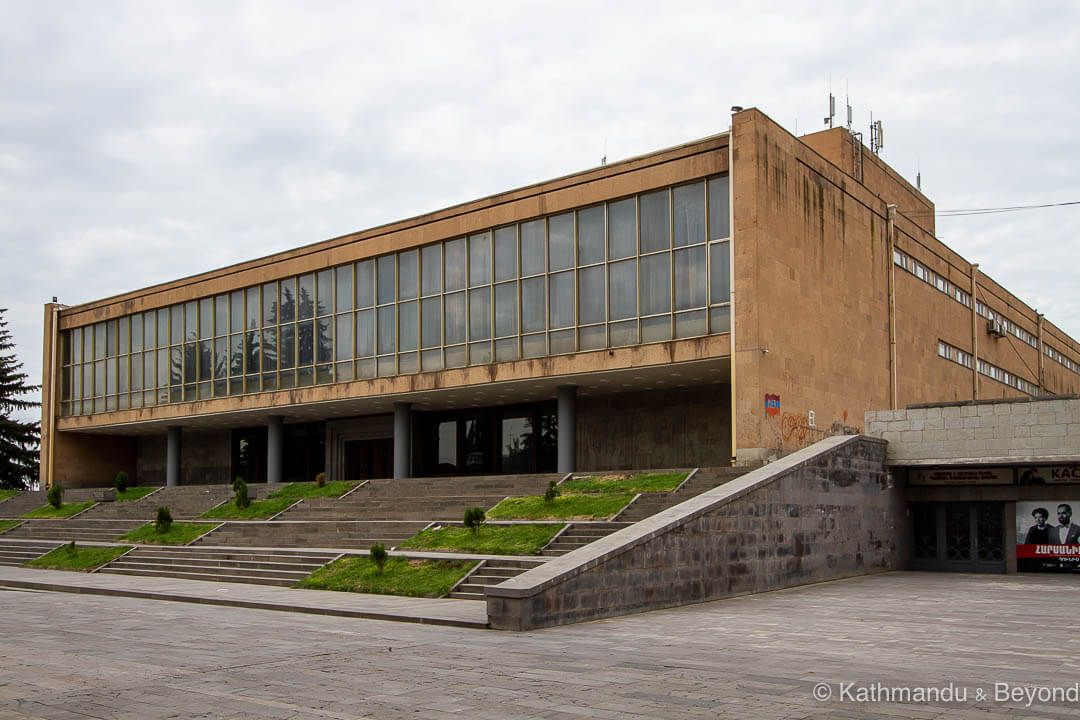
Children’s amusement park
There is plenty of character, as well as colour, in this rather shabby amusement park for kids, which is located just to the right of the drama theatre in Kalbasi Park. I’m reasonably confident that most of the rides, as well as the quaint ticket booth, date from the Soviet period.
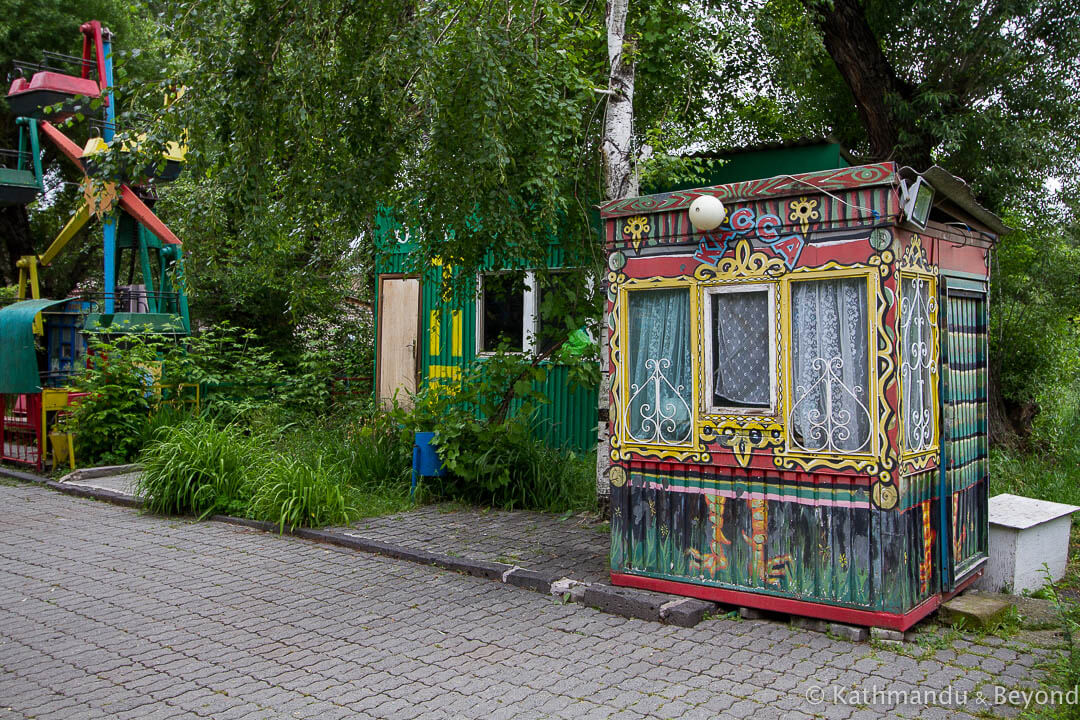
Gyumri Railway Station
Even if you’re not intending to catch a train, it is worth detouring from the centre of Gyumri to see the architectural design of Gyumri’s train station. It is a noteworthy example of Soviet-Armenian architecture, a unique style that blended elements of ancient Armenian architecture with many of the characteristics of Soviet Modernism. The railway station in Gyumri was designed in 1979 by Rafik Yeghoyan, the same architect responsible for the layout of the city’s Mother Armenia complex.
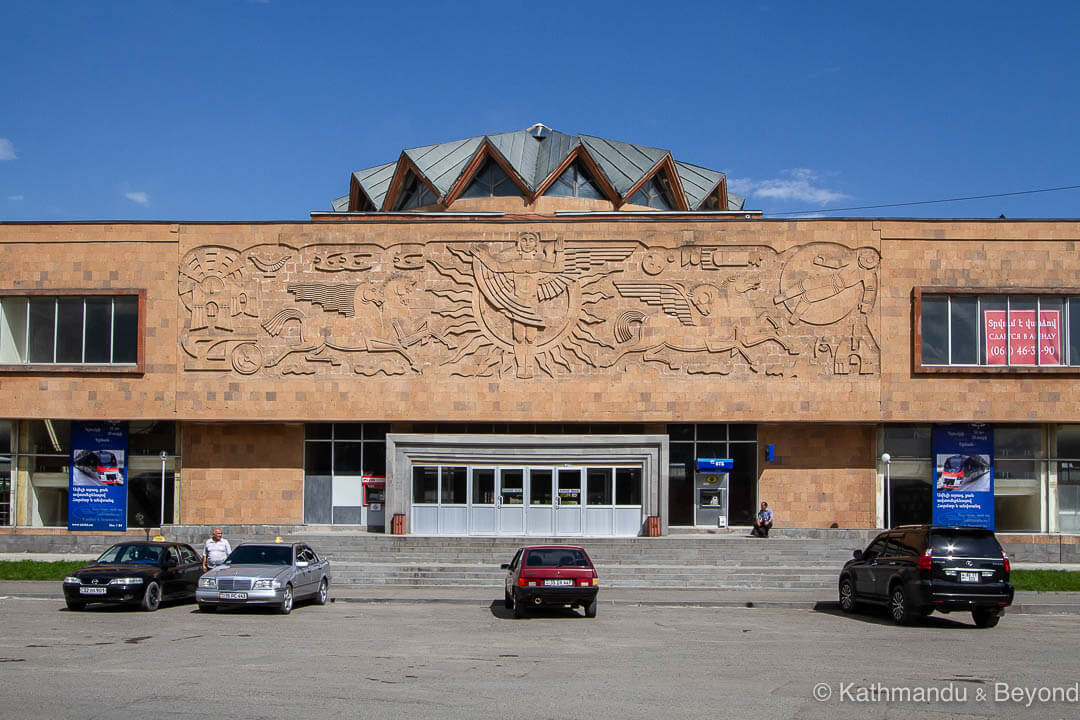
Gyumri House Museum and Museum of the Aslamazyan Sisters
There are a couple of museums of note in Gyumri. We tend not to visit conventional museums and true to form, we haven’t visited either of these but it would be remiss of me not to mention them in this post.
And that completes our list of twenty-one things to do in Gyumri!
Day trips from Gyumri
There are a few worthy day trips from Gyumri. The distance involved for each of them isn’t far and they can all be reached by public transport but you might have to factor in a bit of walking and/or hanging around if transportation schedules don’t work in your favour. The other option, and one we personally use a fair bit in Armenia (and the rest of the Caucasus for that matter), is to stick your thumb out and hitch some of the distance that needs to be covered. We’ve always found hitching easy in this part of the world but I appreciate it isn’t for everyone (*). The alternative, assuming you don’t have your own transport, is to negotiate a taxi to include waiting time while you look around.
(*) For more on our thoughts and experiences regarding hitching in Armenia, click here.
Spitak
If you want to learn more about the 1988 earthquake, consider visiting the town of Spitak. Situated 45km east of Gyumri, on the route to Vanadzor, Spitak was the nearest town to the epicentre of the quake and was so badly damaged, the new town had to be rebuilt in a slightly different location. One reason to visit Spitak is to see the lonesome metal church and the surrounding cemetery where many of the 4,000 local residents who died during the tremor are buried. A memorial to the victims of the earthquake is located on a hilltop a short distance from the church and, in the town itself, it is interesting to see how the new central square has been rebuilt using pink tufa, the limestone rock of volcanic origin that gives many of Armenia’s buildings its distinctive look.
How to get to Spitak from Gyumri on public transport
Getting to Spitak from Gyumri on public transport may take a bit of figuring out. There are scheduled marshrutkas running between Gyumri and Vanadzor several times a day (10am, 11am, 1pm, 2pm and 4pm) and, worst-case scenario, it’s only a 3km walk from the junction that leads down to Spitak off the main Gyumri – Vanadzor highway. But, as far as I’m concerned, there has to be public transport directly linking Gyumri and Spitak. When we did the journey, we did it in reverse and were told in Spitak that there was no direct public transport between the two places. But this might have been because we were trying to do the journey in the late afternoon (it’s not uncommon in the Caucasus for public transport to stop running in the late afternoon) combined with communication issues. If visiting Spitak interests you then my suggestion would be to enquire about departure times at the bus station in Gyumri the day before you want to go.
The metal church and cemetery are a couple of kilometres west of the town. If you don’t want to walk or hitch the distance there are plenty of taxis near the central square.
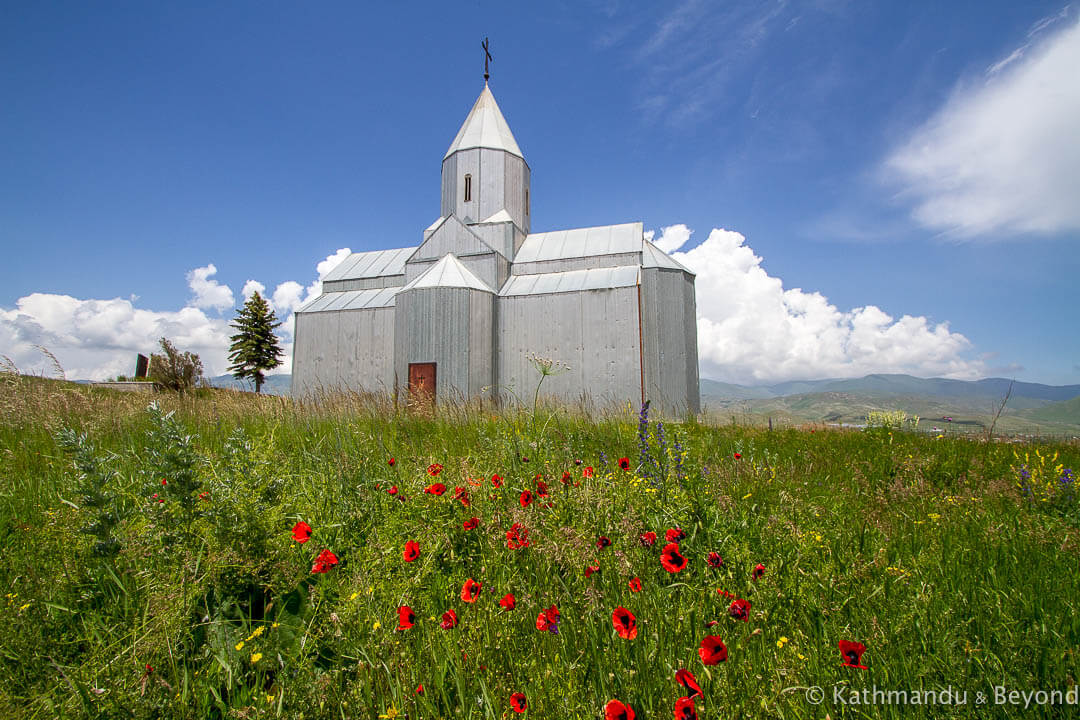
The metal church and cemetery in Spitak
Marmashen Monastery
Marmashen Monastery is an atmospheric 10th-century monastic complex about 15km northwest of Gyumri. The three main churches, of which the biggest is called Saint Stepanos, are clustered together on a picturesque ridge above the Akhurian River and surrounded by fruit trees and several medieval khachkars (stone crosses). The setting is wonderful and if we’d visited using our own transport, I suspect we would have spent much of the day lazing around nearby. Instead, we got to Marmashen Monastery using public transport.
How to get to Marmashen Monastery from Gyumri on public transport
Small buses (not marshrutkas) leave from Gyumri’s bus and marshrutka station for the village of Vahramaberd approximately every hour from 9am to 6pm. Vahramaberd is 2.5km from the churches. Tell the driver where you are going and he will let you out at the turning for the monastery, which is just before the entrance to the village. You will need to walk or hitch a lift the rest of the way. The track to the monastery is a winding one and on the way back, we knocked about a kilometre off the distance by heading through the middle of two fields to the main road and waiting for the bus there.
Alternatively, a taxi from Gyumri to Marmashen Monastery should cost somewhere between 3,000 and 5,000 Armenian dram (approximately 6-10 Euros), depending on how long you need the driver to wait.
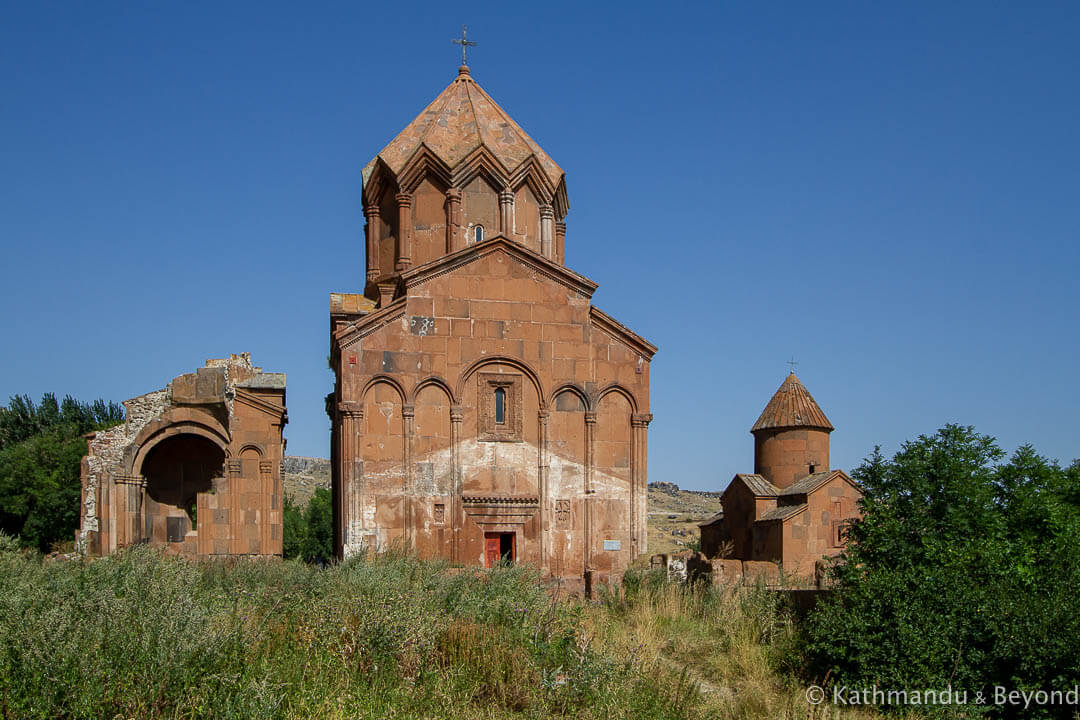
Harichavank Monastery
Harichavank is renowned throughout Armenia because, in 1850, the monastery grounds were expanded and various structures were added so that the complex could become the summer residence of the Catholicos of Etchmiadzin, the governing body of the Armenian Apostolic Church. Situated about 33km northwest of Gyumri, it is yet another monastic complex with a glorious setting (aren’t they all!) and worth the effort of reaching.
How to get to Harichavank Monastery from Gyumri on public transport
We took a bus directly from Gyumri to Harich but this service may no longer be operating so check at the bus station in Gyumri for the latest schedule. The more likely option is that you will have to take a marshrutka to the town of Artik, which is 5km away. Departures from Gyumri are scheduled at 8.30am, 10.30am and 3pm. Once in Artik, the choices are to either walk for around an hour, take a taxi, or hitch. A taxi should cost approximately 500 to 1,000 dram (1-2 Euros).
On the return leg, we waited for a bit but soon realised (with the help of locals) that nothing was going to turn up for quite some time. So, instead, we walked back along the 1.7km track that connects the monastery with the main road heading to Artik on the assumption that we would be able to pick up a passing marshrutka. As it happened, a private car stopped and drove us to Artik, from where we transferred to a marshrutka that took us back to Gyumri.
A taxi from Gyumri to Harichavank Monastery will cost in the region of 7,000 to 10,000 dram (13-20 Euros).
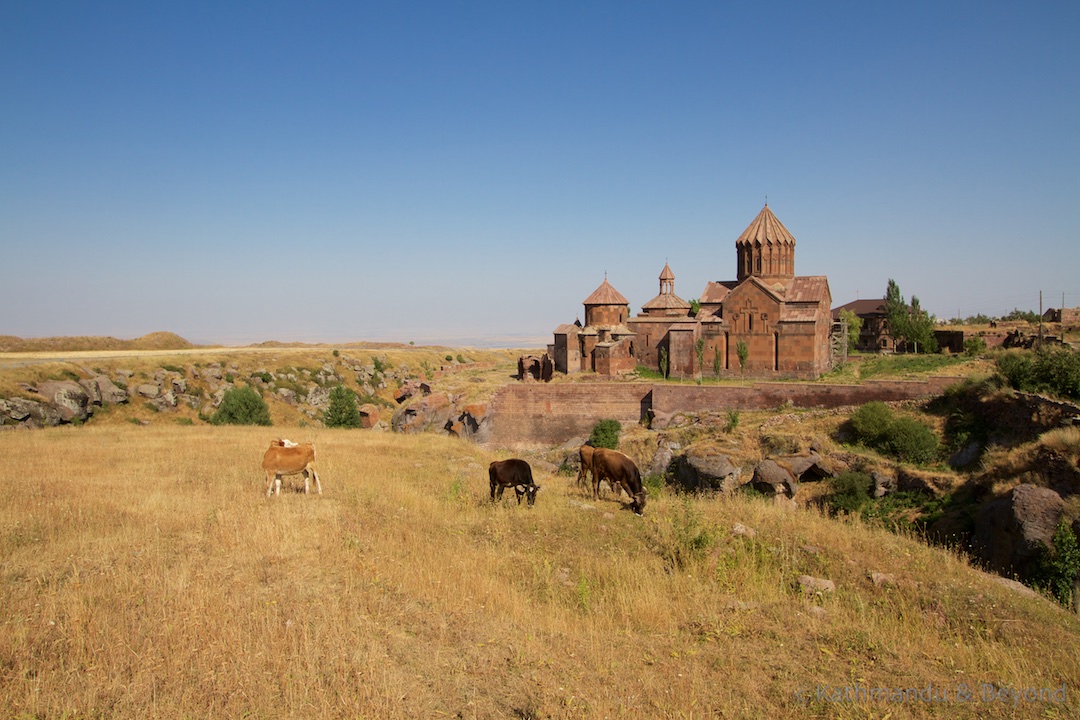
Where to stay in Gyumri
At a push, you could visit Gyumri as a day trip from Yerevan, but we recommend spending a night or two there, especially if you want to exhaust our list of places visit in Gyumri. Although the town centre is very walkable, Gyumri’s size may surprise you so check how far from the centre your accommodation is before booking it. The best location to stay is within walking distance of Vartanants Square and Holy Saviour’s Church.
On our last visit to Gyumri, we stayed at the Golden Apricot Hotel. It was a decent two-star hotel and our only complaint would be that the location was 600 metres less-central than the location marked on Booking.com (If you are considering this hotel, the correct GPS is 40.785783, 43.850093). However, if you are arriving by train and don’t want to walk too far with your luggage, it’s a reasonable choice. A similar style of accommodation, but with a much better location is Araks Hotel Complex.
A large proportion of budget accommodation in Gyumri is in the form of homestay style guesthouses, which offer a more immersive experience, especially as Armenian hospitality is so warm and generous. One such option we previously stayed at is this friendly B&B. Other similar guesthouses with high guest ratings are Artush & Raisa B&B and Guest House ART.
If you’re not a budget traveller or are thinking about splashing out, Gyumri has some well-priced luxury hotels. For around US$50 a night, the Hotel Plaza Viktoria is arguably the best hotel in Gyumri. If over-the-top kitsch makes you swoon, consider the Alexandrapol Palace Hotel. One Tripadvisor guest sums it up perfectly, describing the decor to be a mixture of 19th-century Bohemian hotel and Las Vegas-style (in which Americans try to copy European culture and end up with a Disneyland atmosphere). However, if you prefer your surroundings to be a little more contemporary, the Berlin Art Hotel will probably suit you better.
If you prefer to stay in a hostel in Gyumri, check out the newly opened Loft Hostel.
Where to eat in Gyumri
Regular readers will know that our blog is not the place to come for advice on the best restaurants or coolest bars in town. You will know that if we find what we consider to be a decent place to eat (nice food, good atmosphere, reasonable service, cold beer and keen prices) then we don’t bother looking for anywhere else. Apart from breakfast, which has been included in our room rate both times we have stayed in Gyumri, we have eaten every other meal at the “Gyumri” Hatsatun Restaurant. It serves Armenian and Georgian dishes, has (one) English menu, and you can sit outside in the summertime – what more do you need! If you like cute cafes, Herbs & Honey is the kind of place that I loathe, but that Kirsty would love to frequent once in a while!
How to get to Gyumri
By train
Using public transport, the most straightforward way to get to Gyumri from Yerevan is by train.
Following the introduction of a new electric express train in 2019, it’s possible to travel between Yerevan and Gyumri in just over two hours BUT… currently only on Fridays, Saturdays and Sundays. On those days, the train currently leaves Yerevan Railway Station at 9.15 am and arrives in Gyumri at 11.25 am. The return journey departs at 5.55 pm, arriving in Yerevan at 7.05 pm. On other days of the week, you are stuck with the regular Soviet-style daily train which takes just over three hours to complete the journey. The wooden seats mean it’s not the most comfortable of trains, but it’s far less cramped than a marshrutka! You can check the train schedules on the Armenian Railways website (although it’s a bit hit and miss whether it will translate to English and times are subject to change, so it would be wise to check any train timings locally).
By bus (marshrutka)
There are regular marshrutkas running between Yerevan and Gyumri, and the journey time is usually around 2½ hours. You can take a marshrutka from Yerevan’s Kilikia (Central) Bus Station and the fare should be 1,500 dram. You should also be able to pick up a marshrutka from the car park area close to the main train station and Sasuntsi Davit metro station (sometimes referred to as the southern bus station).
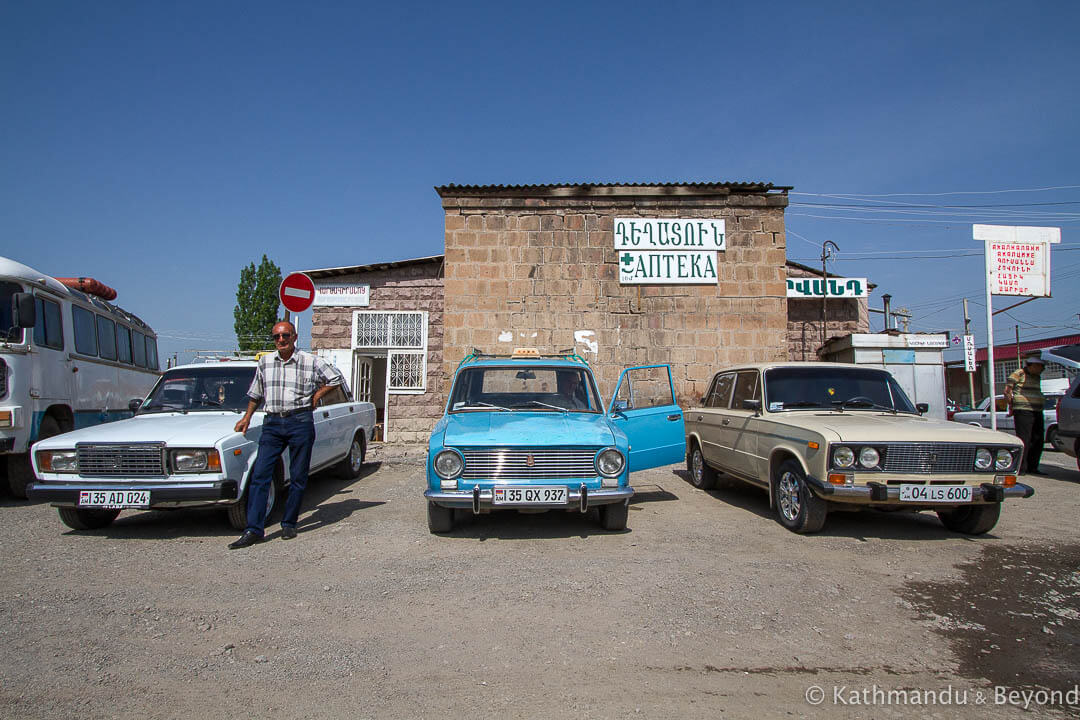
Flights to Gyumri
Although Gyumri has an international airport, flight options are limited. Currently, Ryanair flies from Memmingen in Germany and Athens in Greece, and the Russian low-cost carrier, Pobeda Airlines, has flights from Moscow. Hopefully, more airlines will follow suit.
Onward travel from Gyumri
Even though Turkey is so close, it is not possible to cross from one country to the other. On the other hand, the little-used Bavra – Ninotsminda border crossing, which links this part of northern Armenia with southern Georgia, is open to travellers. There is public transport on the route and this is a great way of getting to the cave monastery at Vardzia and the spa town of Borjomi, both in Georgia. What’s more, if you did want to go from Armenia to Turkey, going to Akhaltsikhe in Georgia and then crossing from there is the most direct route. We have written a more detailed post about the Gyumri to Georgia border crossing, which you can find here. It is also possible to take the train from Gyumri to Batumi and Tbilisi, in Georgia.
Useful bus/marshrutka times from Gyumri
Gyumri to Yerevan at 7am to 7pm, departing when full
Gyumri to Vanadzor: marshrutkas at 10am, 11am, 1pm, and by bus at 4pm
Gyumri to Tbilisi (Georgia) departs at 1030am
Gyumri to Akhaltsike (Georgia) departs at 10am
Gyumri to Anipemza departs at 1pm
With thanks to Armen at Travel Gyumri, the city’s tourist information portal, for obtaining up-to-date transport timings for us. You can contact him for further information regarding places to visit in Gyumri by email at [email protected].
READ MORE BLOG POSTS ABOUT ARMENIA
Socially responsible tourism in Gyumri
If giving back is something you try to do on your travels, you might like to check out this Gyumri initiative that aims to empower local women through tourism. Adventures in Preservation believe that, through tourism, they can change the social and economic status of women who live in Gyumri and in particular in rural communities of Shirak province. They offer a selection of cultural tours and experiences which range from spending time with and helping out local village families and learning to cook traditional Shirak food, to participating archaeology projects involved in the restoration and preservation of Gyumri’s historic buildings. For more information, read more about the project and its aims on their website. We haven’t had the opportunity to check out this project in person yet, but it was highlighted to us by the local tourist information centre.
IF YOU FOUND OUR GUIDE TO PLACES TO VISIT IN GYUMRI HELPFUL, PLEASE SHARE IT…
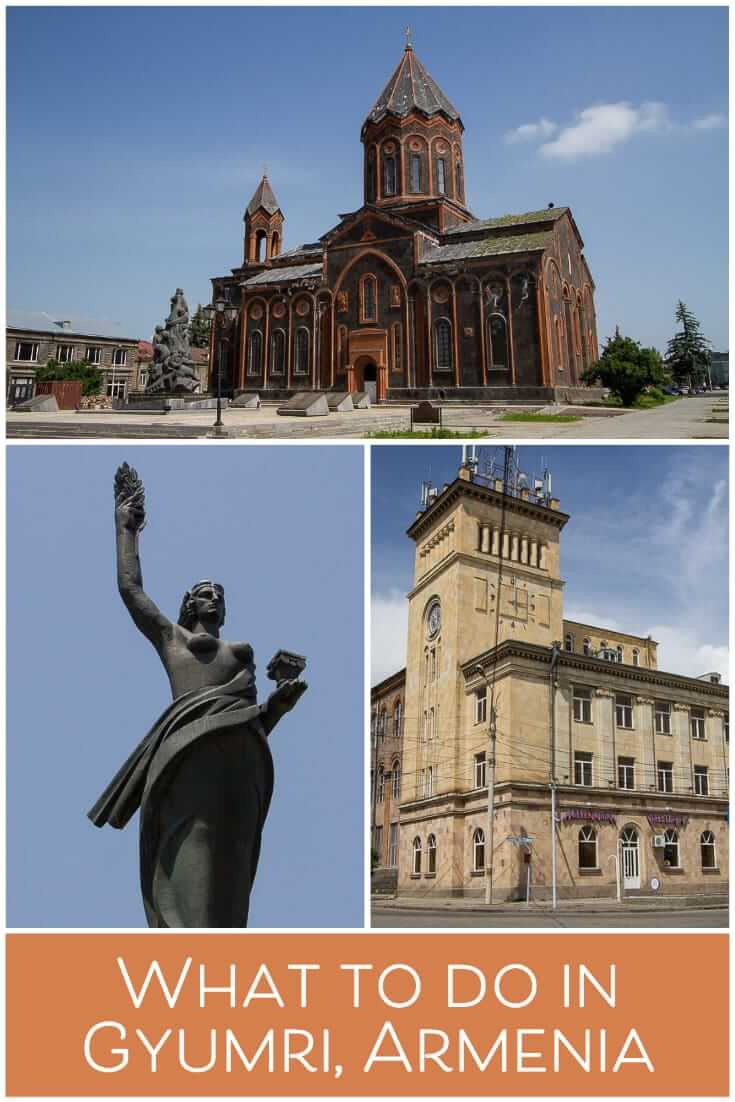
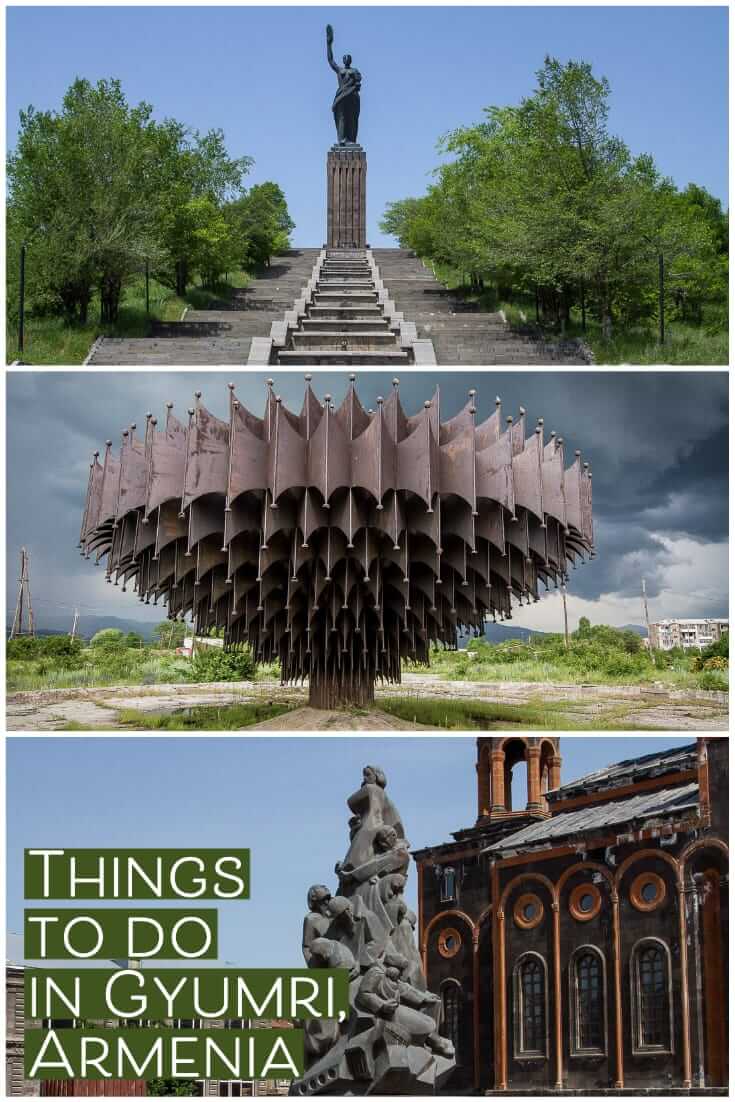
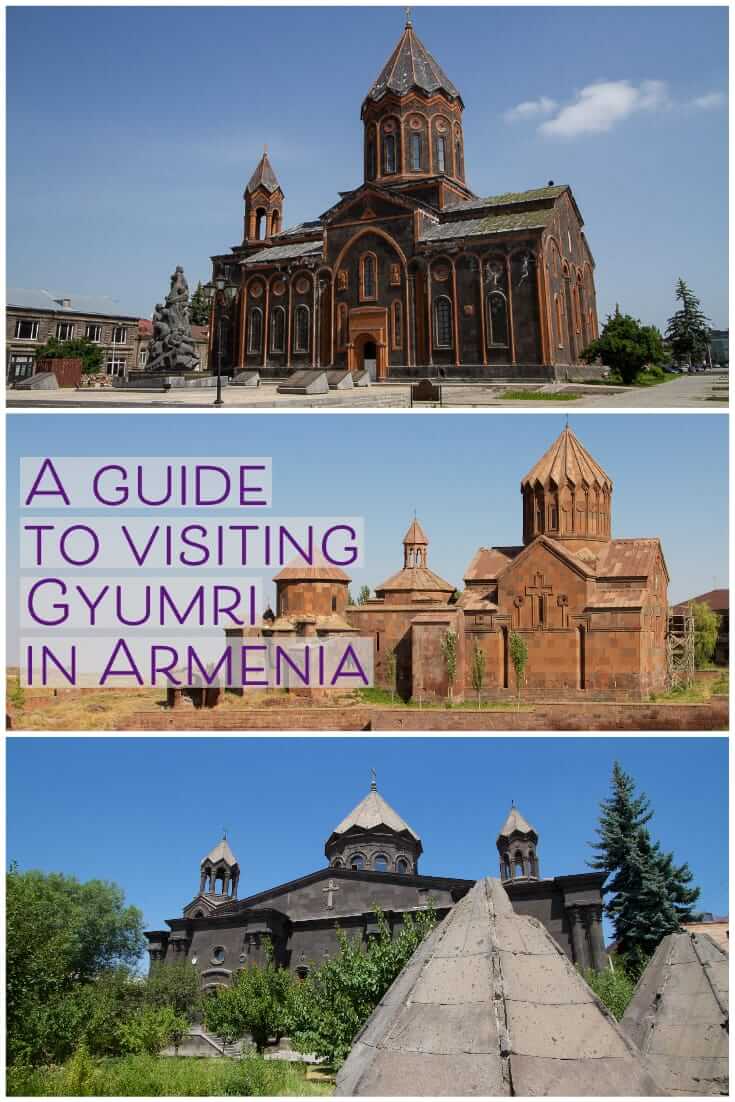

This was a very interesting overview of this town, many details not found in my guidebooks. Good work!
Great, thank you for letting us know!